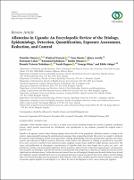| dc.contributor.author | Omara, Timothy | |
| dc.contributor.author | Nassazi, Winfred | |
| dc.contributor.author | Omute, Tom | |
| dc.contributor.author | Aburu, Awath | |
| dc.contributor.author | Laker, Fortunate | |
| dc.contributor.author | Kalukusu, Raymond | |
| dc.contributor.author | Musau, Bashir | |
| dc.contributor.author | Nakabuye, Brenda Victoria | |
| dc.contributor.author | Kagoya, Sarah | |
| dc.contributor.author | Otim, George | |
| dc.contributor.author | Adupa, Eddie | |
| dc.date.accessioned | 2020-11-09T12:04:37Z | |
| dc.date.available | 2020-11-09T12:04:37Z | |
| dc.date.issued | 2020 | |
| dc.identifier.citation | Omara, T., Nassazi, W., Omute, T., Awath, A., Laker, F., Kalukusu, R., ... & Adupa, E. (2020). Aflatoxins in Uganda: An Encyclopedic Review of the Etiology, Epidemiology, Detection, Quantification, Exposure Assessment, Reduction, and Control. International Journal of Microbiology, 2020. | en_US |
| dc.identifier.uri | https://hdl.handle.net/123456789/181 | |
| dc.description.abstract | Uganda is an agrarian country where farming employs more than 60% of the population. Aflatoxins remain a scourge in the
country, unprecedentedly reducing the nutritional and economic value of agricultural foods. *is review was sought to synthetize
the country’s major findings in relation to the mycotoxins’ etiology, epidemiology, detection, quantification, exposure assessment,
control, and reduction in different matrices. Electronic results indicate that aflatoxins in Uganda are produced by Aspergillus
flavus and A. parasiticus and have been reported in maize, sorghum, sesame, beans, sunflower, millet, peanuts, and cassava. *e
causes and proliferation of aflatoxigenic contamination of Ugandan foods have been largely due to poor pre-, peri-, and
postharvest activities, poor government legislation, lack of awareness, and low levels of education among farmers, entrepreneurs,
and consumers on this plague. Little diet diversity has exacerbated the risk of exposure to aflatoxins in Uganda because most of the
staple foods are aflatoxin-prone. On the detection and control, these are still marginal, though some devoted scholars have devised
and validated a sensitive portable device for on-site aflatoxin detection in maize and shown that starter cultures used for making
some cereal-based beverages have the potential to bind aflatoxins. More efforts should be geared towards awareness creation and
vaccination against hepatitis B and hepatitis A to reduce the risk of development of liver cancer among the populace. | en_US |
| dc.language.iso | en | en_US |
| dc.publisher | International Journal of Microbiology | en_US |
| dc.subject | Etiology | en_US |
| dc.subject | Epidemiology | en_US |
| dc.subject | Detection | en_US |
| dc.subject | Quantification | en_US |
| dc.subject | Exposure Assessment | en_US |
| dc.title | Aflatoxins in Uganda: An Encyclopedic Review of the Etiology, Epidemiology, Detection, Quantification, Exposure Assessment, Reduction, and Control | en_US |
| dc.type | Article | en_US |

